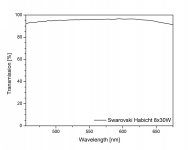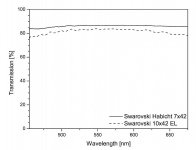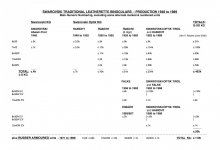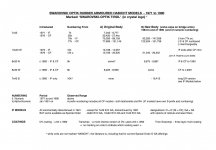Hi Andy,
As you indicate the Habicht line of binoculars is long established. And in terms of coatings it’s hard to imagine that significant change is possible
The Habichts:
- already have extremely high transmission, stated by Swarovski to be 96% for all 3 models
- and are known for their paper white image
This performance dates back to 2009, when Swarovski in anticipation of the EL Swarovsion introduction acquired new coating machinery,
and applied the new coating processes to all models
See the comments by Dale Forbes of Swarovski at:
https://www.birdforum.net/showpost.php?p=1639843&postcount=29
Various tests by Gijs van Ginkel confirm the transmission
e.g. see the graph for an 8x30W from a May 2016 test which can be found at:
https://www.houseofoutdoor.com/verrekijkers/verrekijkers-testen-en-vergelijken/
It shows peak transmission of 96%, and even more impressively minimum transmission at the two ends of the recorded spectrum at around 92% and 91%
If anything the 7x42 may have higher transmission, as it has a simpler eyepiece of 3 elements in 2 groups verses 6 in 3 for both the 8x30W and 10x40W
Though any increase is likely to be minimal
Even prior to the 2009 update, transmission levels were already high e.g. see the graph for a 7x42 unit from a 2010 test
It shows maximum transmission of 86%, and around 84% and 85% at the two ends of the range
- - - -
In relation to the focuser mechanism, see my recent comments in post #15 at:
https://www.birdforum.net/showthread.php?t=388805 )
It seems that the mechanism does not necessarily need to be as firm as it is
- - - -
I’ve previously posted some information about Swarovski’s production process at:
https://www.birdforum.net/showthread.php?t=375640
Like other manufacturers, they would include computerised inventory management and Just In Time supply, to minimise on-hand inventory
(though there may potentially be hold-ups in the current C-19 situation)
From looking at the serial numbers of models for sale on the net, it’s clear that Swarovski assembles Habichts as needed to meet orders
All 3 magnifications are assembled and dispatched at least several times a year (and for the last few years that's around 2,000 units per year)
- though presumedly components may be actually manufactured on a less frequent basis
Swarovski's numbering practices allow a product to be dated to its week of production. However, this seems to contribute to a degree of unnecessary customer worry
In contrast, as other brands cannot be so precisely dated, customers seem much more ready to accept that any new example of a current model is up to date,
and therefore 'the best'
John









